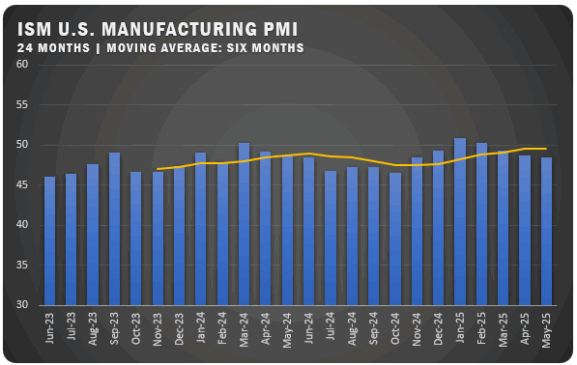US Manufacturing Pushes Toward Growth
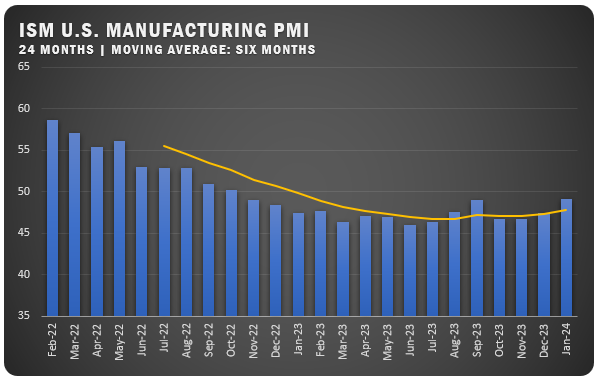
Global Manufacturers Also See Upward Movement in January
The Manufacturing PMI® for January was reported at 49.1 percent in the latest Manufacturing ISM® Report On Business® released by the nation’s supply executives. The figure represented a two-percentage-point increase from December’s figure of 47.1 percent but remained in contraction territory.
Timothy R. Fiore, CPSM, C.P.M., Chair of the Institute for Supply Management® Manufacturing Business Survey Committee, highlighted key findings in the report saying the overall economy continued to expand for the 45th consecutive month, with the New Orders Index rising to 52.5 percent, reflecting an increase of 5.5 percentage points from December. Similarly, the Production Index inched into expansion territory at 50.4 percent, showing a marginal improvement from the previous month.
Price levels also experienced upward pressure, with the Prices Index climbing to 52.9 percent, indicating a 7.7-percentage-point increase from December. However, the Backlog of Orders Index declined slightly to 44.7 percent, while the Employment Index fell to 47.1 percent, indicating a reduction in employment levels compared to the previous month.
Furthermore, Fiore noted that while the manufacturing sector continued to contract, the pace of contraction had slowed compared to December. Demand showed moderate improvement, with new orders expanding at a respectable rate, although new export orders faced headwinds. Despite this, the Backlog of Orders Index remained in fairly strong contraction territory.
On the supply side, Fiore mentioned that suppliers continued to accommodate future demand growth, although there were signs of stiffening, particularly in supplier deliveries and inventories. The Supplier Deliveries Index indicated faster deliveries for the 16th consecutive month, while the Inventories Index increased slightly but remained in moderate contraction territory.
Looking at specific industries, two of the six largest manufacturing sectors — Transportation Equipment and Chemical Products — registered growth in January. However, demand remained soft overall, with production execution stable compared to December. Sixty-two percent of manufacturing gross domestic product (GDP) contracted in January, down from 84 percent in December, indicating a slight improvement.
US SECTOR REPORT
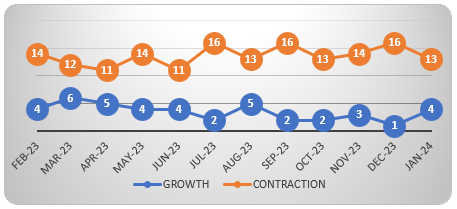
ISM® GROWTH SECTORS (4): Apparel, Leather and Allied Products; Textile Mills; Transportation Equipment; and Chemical Products.
ISM® CONTRACTION SECTORS (13): Wood Products; Machinery; Plastics and Rubber Products; Nonmetallic Mineral Products; Furniture and Related Products; Computer and Electronic Products; Fabricated Metal Products; Petroleum and Coal Products; Food, Beverage and Tobacco Products; Electrical Equipment, Appliances and Components; Paper Products; Miscellaneous Manufacturing; and Primary Metals.
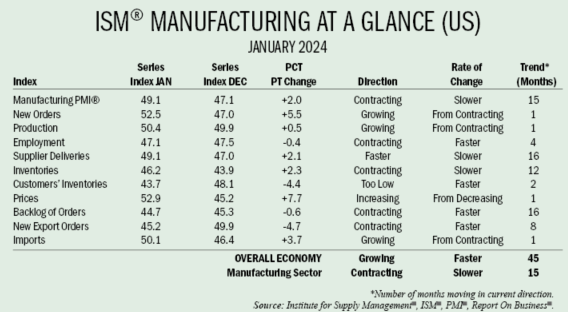
JANUARY ISM® REPORT COMMENTS
(U.S. Manufacturers)
- “The start of 2024 looks good. Sales are above expectations, and costs are mostly stable. A few commodities are up in cost due to supply shortages. Many previously short commodities market positions have corrected themselves. There is a real short-term increase in the cost of international freight.” Chemical Products
- “The commercial vehicle market appears to be retracting a bit in 2024 compared to last year. Forecast sales have decreased slightly in most product segments, with only limited growth related to customers’ competitive sourcing and moves to new technology. Most supply chains, including for semiconductors, have stabilized, with the only major escalation now being transit through the Red Sea.” Transportation Equipment
- “Business continues to stabilize. Cash flow will be tight in 2024.” Food, Beverage and Tobacco Products
- “U.S. economic outlook is affecting customer orders, and the current backlog is quite low compared to past quarters. Waiting on potential improvements from the CHIPS and Science Act.” Computer and Electronic Products
- “December sales were very strong but slower for the first part of January, as was expected. We expect to see steady sales going forward if the (U.S. Federal Reserve) continues to hold rates and suggests a rate cut in the future.” Machinery
- “Good start to the year. We had budgeted a 3.5-percent increase over 2023. We expect it to be a challenging year. Currently, orders are positive in our automotive OEM and automotive aftermarket business. Our industrial business sector is looking weak at the moment. Still expect to achieve budget forecasts through the first quarter. (We) feel January is running high for automotive because at the end of December, many OEMs canceled the last few weeks of orders to reduce inventory levels.” Fabricated Metal Products
- “Order backlog, which was at historically high levels, is diminishing due to supply chain improvements and slight slowdown of orders.” Miscellaneous Manufacturing
- “Demand continues to be slow. Reduction from the second half of 2023 has continued into this year. We are adjusting production to match demand.” Electrical Equipment, Appliances and Components
- “Current industry conditions are positive; however, a note of caution as we see potential headwinds with downward price movements in the coming months.” Primary Metals
- “Remarkable slowdown in business in December. January has picked up, but not to previous-year levels.” Textile Mills
GLOBAL PMI NOTES
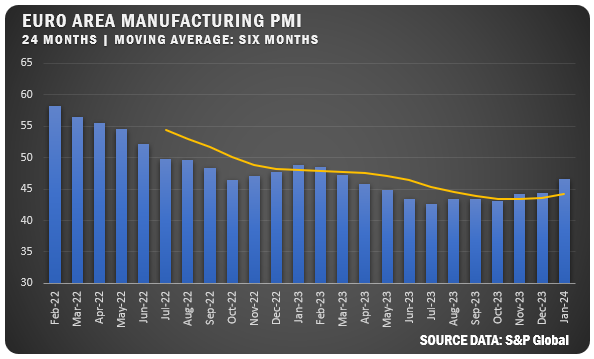
EUROZONE: The HCOB Eurozone Manufacturing PMI pushed up to 46.6 percent in January 2024, reaching a 10-month high. New orders and output both increased sharply. Export orders declined, but there was still excess capacity at factories. Employment fell but not as rapidly as in previous months. Business confidence was the highest since April 2023.
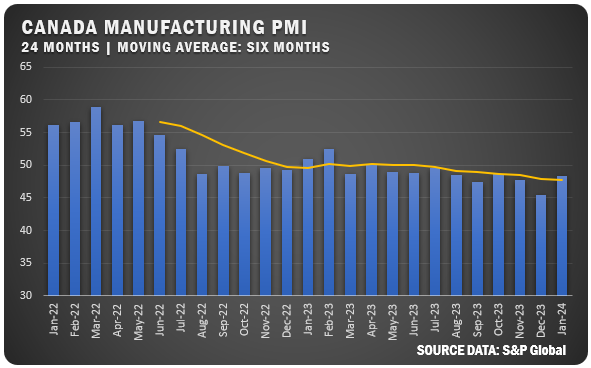
CANADA: The S&P Global Canada Manufacturing PMI jumped to 48.3 percent in January, up from 45.4 percent in December. Production continued a decline for a sixth consecutive month. New orders also fell but at a slower rate. Companies pulled back slightly on employment and backlogs of work have now decreased for 18 straight months. Shipping delays were reported based on the Red Sea crisis but input prices and output charges still increased at slower rates. Business confidence reached a six-month high.
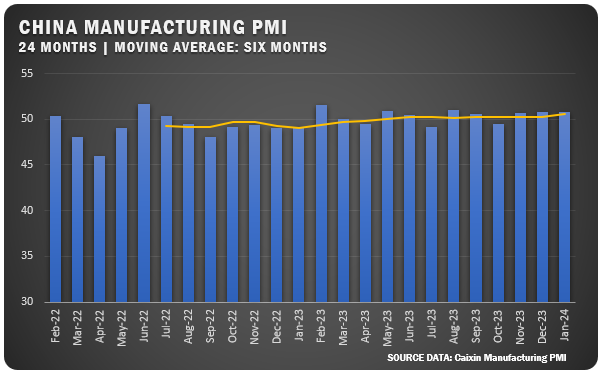
CHINA: The January Caixin China General Manufacturing PMI repeated the December figure of 50.8 percent to register a third straight month of growth for Chinese factories. Output was solid with export sales growing for the first time in seven months. Purchasing levels showed a strong increase but companies still cut employment but at a slower pace. Supply chains continued to improve and input cost increases also slowed. Business optimism reached a nine-month high.
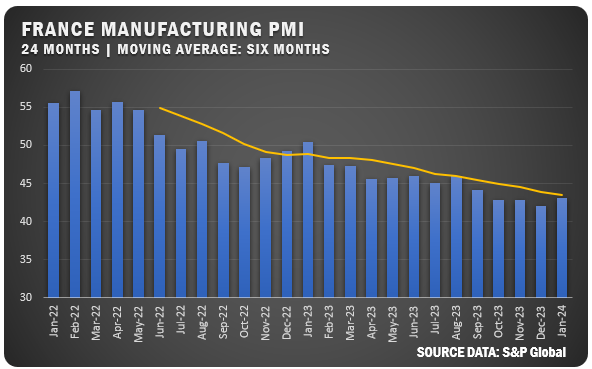
FRANCE: The HCOB France Manufacturing PMI came in at 43.1 percent for January to push up from the three-year low of 42.1 percent registered in December. Despite the uptick, French manufacturers have been in contraction territory since last February. January’s improved figure saw new orders decrease at the slowest rate in seven months. Delivery times extended sharply and purchasing activity also fell. Thanks to lower oil and energy expenses, input prices fell for the second consecutive month. Business outlook was pessimistic as companies are worried about a drop in demand.
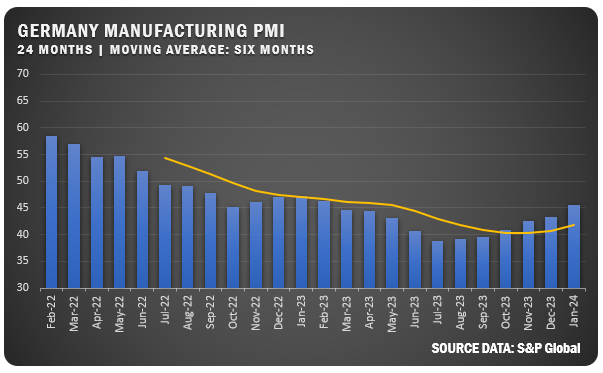
GERMANY: The HCOB Germany Manufacturing PMI rolled up to 45.5 percent in January, compared to 43.3 percent the previous month. While the index is still well below the 50 percent mark representing growth territory, German manufacturing has rapidly been climbing from a low of 38.8 percent set in July. For January, the new order decline eased up along with the decline in foreign sales. Employment cutbacks are still in effect and input costs and output pricing are both still low. Business confidence remains weak.
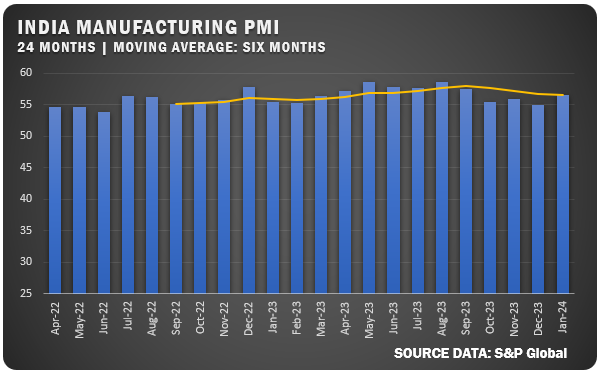
INDIA: The HSBC India Manufacturing PMI bumped up again to register 56.5 percent for January. That was a good step up from the December figure of 54.9 percent. Output and new orders increased to a four-month high and exports also looked strong. Purchasing activity also showed strength while input prices pushed up to a three-month high. Input cost inflation also saw a three-month high. Employment remained flat, but business optimism reached a 13-month peak.
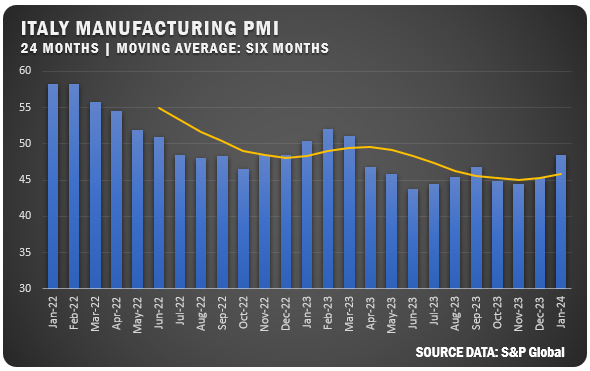
ITALY: The HCOB Italy Manufacturing PMI surged to 48.5 percent in January up from 45.3 in the prior month. The new figure was the highest since March 2023. Still, Italian manufacturing remains below the target line for a tenth consecutive month. Output and new orders declined at a slower rate while purchasing activity continued a decline that has now reached 12 straight months. Delivery times extended for the first time in 12 months due to disruptions in the Red Sea. Business optimism reached a five-month high.
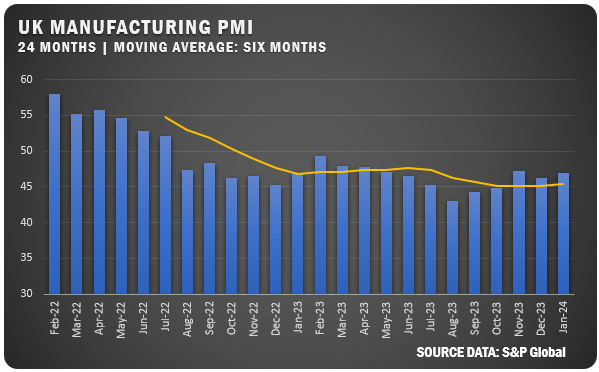
UNITED KINGDOM: The S&P Global UK Manufacturing PMI bounced back up to 47 percent in January 2024 after registering a disappointing 46.2 percent in December. That nearly matched the November reading of 47.2 percent as the country looks for recovery in the manufacturing sector. Output and new orders fell and employment reductions followed along with purchasing and inventory. Supply chain issues also re-surfaced due to the Red Sea crisis as deliveries were redirected through the Suez Canal. Still, business outlook was at a four-month high.
Source: Institute for Supply Management® , PMI® (Purchasing Manager Index), Report On Business® . For more information, visit the ISM® website at www.ismworld.org.


